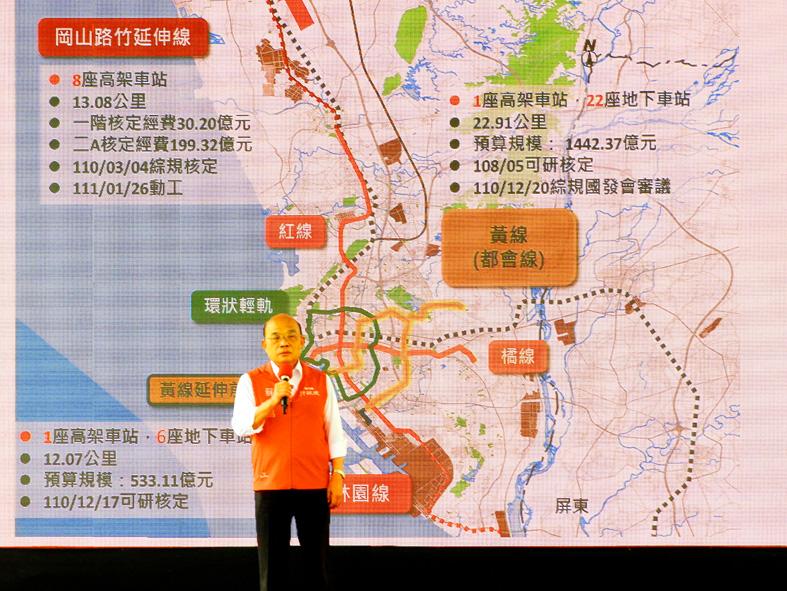The Executive Yuan on Friday approved a plan to build a new line on the Kaohsiung Mass Rapid Transit (MRT) system, Premier Su Tseng-chang (蘇貞昌) announced yesterday.
Su made the announcement during an inspection tour in the city.
The Kaohsiung City Government said construction of the new line would begin by the end of this year and it would open by the end of 2028.

Photo: Ko Yu-hao, Taipei Times
The project has been allocated a budget of NT$144.2 billion (US$5.08 billion), with the central government covering NT$83.38 billion and the city government paying for the rest.
The proposed Yellow Line would connect Kaohsiung’s Red and Orange MRT lines, as well as a light-rail system and a railway station, the Kaohsiung Mass Rapid Transit Bureau said.
The line would extend 22.91km — 1.08km above ground and 21.83km below ground — with 23 stations and a maintenance depot, the National Development Council has said.
It would pass through Niaosong (鳥松), Sanmin (三民), Lingya (苓雅), Sinsing (新興), Fongshan (鳳山) and Cianjhen (前鎮) districts, and serve 1.16 million people, or about 41.8 percent of the city’s population, the bureau said.
It would pass through neighborhoods home to three universities and seven junior-high schools, high schools and vocational schools, the bureau added.
In related news, the Ministry of Transportation and Communications on Tuesday approved the route for a proposed MRT line that would connect New Taipei City’s Xizhi District (汐止) and Taipei’s Donghu (東湖) area.
The plan needs approval by the Executive Yuan.
The elevated line would take nine years to build and would meet long-standing calls by Xizhi residents to improve public transport links in the area, the New Taipei City Department of Rapid Transit Systems said.
The planned line would stretch eastward from Donghu MRT Station, which is part of the Taipei MRT system, to the Xizhi District Office, where passengers would be able to transfer to Xizhi Railway Station operated by the Taiwan Railways Administration, the department said.
The line would have four stations and would also connect to a planned MRT line connecting Keelung and Taipei, it said.
The 5.56km line, 4.75km of which is to run through New Taipei City, is expected to cost NT$37.7 billion, said the department, which is responsible for the line’s construction.
There is a separate plan to extend the proposed line westward from Donghu to Taipei’s Dadaocheng (大稻埕) area. That section would be underground, running roughly parallel to the Songshan MRT Line. The Taipei Department of Rapid Transit Systems is responsible for its planning.
The entire proposed line stretching 17.4km from Xizhi to Dadaocheng would further integrate transport links in Taipei and New Taipei City by connecting Taipei’s Datong (大同), Zhongshan (中山), Songshan (松山) and Neihu (內湖) districts with Xizhi, the department said.

Chinese Nationalist Party (KMT) Chairman Eric Chu (朱立倫), spokeswoman Yang Chih-yu (楊智伃) and Legislator Hsieh Lung-chieh (謝龍介) would be summoned by police for questioning for leading an illegal assembly on Thursday evening last week, Minister of the Interior Liu Shyh-fang (劉世芳) said today. The three KMT officials led an assembly outside the Taipei City Prosecutors’ Office, a restricted area where public assembly is not allowed, protesting the questioning of several KMT staff and searches of KMT headquarters and offices in a recall petition forgery case. Chu, Yang and Hsieh are all suspected of contravening the Assembly and Parade Act (集會遊行法) by holding

PRAISE: Japanese visitor Takashi Kubota said the Taiwanese temple architecture images showcased in the AI Art Gallery were the most impressive displays he saw Taiwan does not have an official pavilion at the World Expo in Osaka, Japan, because of its diplomatic predicament, but the government-backed Tech World pavilion is drawing interest with its unique recreations of works by Taiwanese artists. The pavilion features an artificial intelligence (AI)-based art gallery showcasing works of famous Taiwanese artists from the Japanese colonial period using innovative technologies. Among its main simulated displays are Eastern gouache paintings by Chen Chin (陳進), Lin Yu-shan (林玉山) and Kuo Hsueh-hu (郭雪湖), who were the three young Taiwanese painters selected for the East Asian Painting exhibition in 1927. Gouache is a water-based

Taiwan would welcome the return of Honduras as a diplomatic ally if its next president decides to make such a move, Minister of Foreign Affairs Lin Chia-lung (林佳龍) said yesterday. “Of course, we would welcome Honduras if they want to restore diplomatic ties with Taiwan after their elections,” Lin said at a meeting of the legislature’s Foreign Affairs and National Defense Committee, when asked to comment on statements made by two of the three Honduran presidential candidates during the presidential campaign in the Central American country. Taiwan is paying close attention to the region as a whole in the wake of a

OFF-TARGET: More than 30,000 participants were expected to take part in the Games next month, but only 6,550 foreign and 19,400 Taiwanese athletes have registered Taipei city councilors yesterday blasted the organizers of next month’s World Masters Games over sudden timetable and venue changes, which they said have caused thousands of participants to back out of the international sporting event, among other organizational issues. They also cited visa delays and political interference by China as reasons many foreign athletes are requesting refunds for the event, to be held from May 17 to 30. Jointly organized by the Taipei and New Taipei City governments, the games have been rocked by numerous controversies since preparations began in 2020. Taipei City Councilor Lin Yen-feng (林延鳳) said yesterday that new measures by